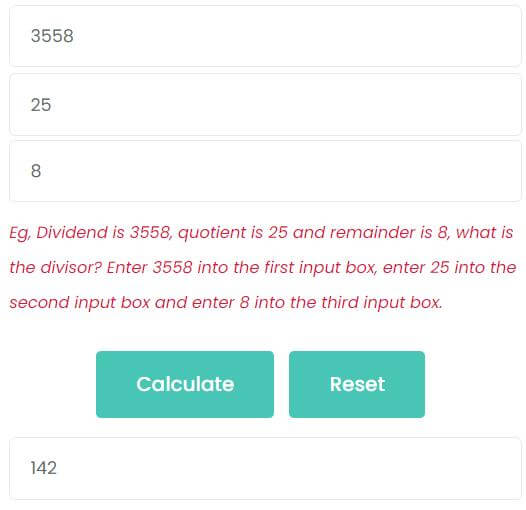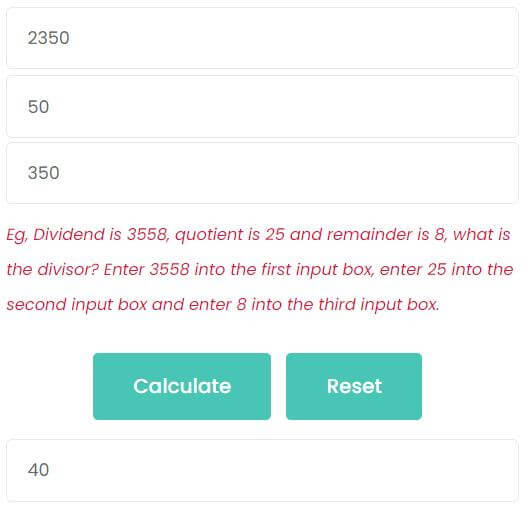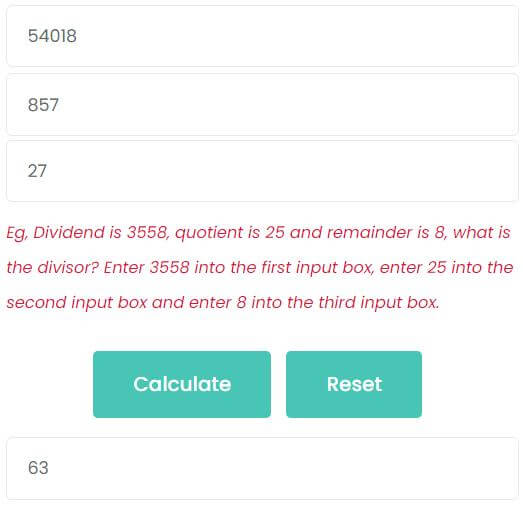Welcome to the divisor calculator, which can help you quickly calculate the value of the divisor based on the dividend, quotient and remainder. Such as, what is the divisor if dividend is 3558, quotient is 25 and remainder is 8?
Definition and Formulas
The divisor is the number after the division sign in the division operation. According to the division formula
Dividend ÷ Divisor = Quotient・・・Remainder
Then, the formula for calculating the divisor can be deduced as follows:
Divisor = (Dividend – Remainder) ÷ Quotient
For example, dividend = 3558, quotient = 25, remainder = 8, what is the divisor?
Divisor = (Dividend – Remainder) ÷ Quotient
= (3558 – 8) ÷ 25
= 142
This is the manual calculation method using the formula. Let’s see how to achieve automatic calculation through the divisor calculator.
How to use the divisor calculator
The procedure to use divisor calculator is as follows:
- Enter the dividend.
- Enter the quotient.
- Enter the remainder, if not, leave blank or enter 0.
- Click Calculate button to get the divisor.
- Click the Reset button to start a new calculation.
Solved examples using divisor calculator
Example 1, what is the divisor if dividend is 3558, quotient is 25 and remainder is 8?
Calculate by calculator
Enter 3558 into the first input box.
Enter 25 into the second input box.
Enter 8 into the third input box.
Then click Calculate button, as shown in the figure, the divisor is 142, consistent with manual calculation.

Example 2, What is the divisor when the dividend is 2350 and the quotient is 50 with a remainder of 350?
Manual calculation
(2350 – 350) ÷ 50 = 40
Calculate by calculator
Enter 2350 into the first input box.
Enter 50 into the second input box.
Enter 350 into the third input box.
Then click Calculate button, as shown in the figure, the divisor is 40, consistent with manual calculation.

Example 3, What is the dividend if divisor is 54018, quotient is 857 and the remainder is 27?
Manual calculation
(54018 – 27) ÷ 857 = 63
Calculate by calculator
Enter 54018 into the first input box.
Enter 857 into the second input box.
Enter 27 into the third input box.
Then click Calculate button, as shown in the figure, the divisor is 63, consistent with manual calculation.

Latest calculators
Standard Form to Slope-Intercept Form Calculator
Slope Intercept Form Calculator
Slope Calculator: Calculate Slope, X-Intercept, Y-Intercept
Reciprocal of Complex Number Calculator
Conjugate Complex Number Calculator
Modulus of Complex Number Calculator
Profit Percentage Calculator: Calculate Your Profitability Easily
Attendance and Absence Percentage Calculator
Circular Segment Radius Calculator
Regular Polygon Side Length Calculator